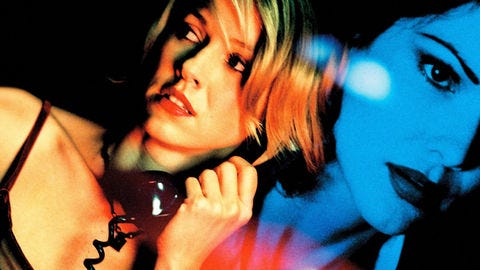Watched (and reviewed) Mar 15, 2024
Copy and pasted from ^my Letterboxd account:
“I had a dream about this place.”
This is definitely my favorite Lynch and probably one of my favorite films in general now. In the same way that directors like Christopher Nolan have perfected using nonlinear sequencing to tell richer and fuller stories, I believe David Lynch accomplished a similar trademark feat with his use of surrealism instead. Of course, the story isn’t exactly told sequentially in a lot of what he does, but his expertise in surrealism reminds me greatly of Nolan’s in sequencing and manipulation of time. I’m kind of talking out of my ass here because I’m not in any way educated on the origins of surrealist cinema in the 20’s, but this comparison and appraisal is the best way I can come up with to express my thoughts. Mulholland Drive has a clear narrative to understand. The surrealism isn’t just present for the purpose of evoking emotion or representing themes. There is much more explicit meaning here. For this reason, Mulholland Drive seems to me like Lynch’s most accessible film. At least so far, it seems like his least necessarily abstract work besides Elephant Man.
“Okay, so you had a dream about this place. Tell me.”
While the stunning diner scene could seem out of place due to its content, the film clearly establishes it as a key, like a map legend or the kind of key seen in the film, for understanding the sum of what is before and after it. This is definitely not the only scene making use of surrealism. Some, but not all, of the other scenes are further helping to communicate the parts of the film taking place in reality and what exactly that reality is.
¡No hay banda!
Like much of Lynch’s filmography, Mulholland Drive effectively includes elements of Film noir, maybe even more so in this one. It can certainly be classified as neo-noir. Taking advantage of the genre conventions of Film noir, thematically, visually, and audibly, many different things are allowed because of this. Between the explicit narrative Naomi Watts journeys through, Lynch also layers in an obvious critique of the Hollywood studio system. The setting of the city of dreams, Los Angeles, is significant for this and many other reasons.
It is all an illusion.
While this film may have the most direct meaning and I may call it Lynch’s least abstract or most easily accessible film, I think it’s important to clarify that this does not change the process of consuming it. You can understand it and you will if you wish to, but you must feel it more than anything else. That might be what I love most about Lynch. His work is art for art’s sake. It has meaning, intentional and uniquely found or discovered, but the meaning in art is not necessarily as important as the very active process of consuming it, of feeling it. The term Lynchian can mean many things. I’ve seen it used to describe subjects differing in many ways. I’d like to believe that like his art, it is something that should remain undefinable except in the process of finding communication.
Mulholland Drive is beautiful. It features fantastic performances, uses sound to incredibly evoke emotion, and it looks amazing. So much more can be said. I could explain my own interpretations and what seems to me to be the most objective interpretation in another spoiler-marked review. For now, all else that I have to say is that I loved it, I can’t wait to watch more films as intriguing and satisfying as this, and I definitely plan on watching it again.
“When you talk about things — unless you’re a poet — a big thing becomes smaller. […] And also, it’s so limiting to say what something is. It becomes nothing more than that, and I like things that can become more than that.”
- David Lynch
I didn’t want to say too much to avoid altering how anyone would view this on a first watch, but it’s definitely deserving of quite a lot of writing and highly recommended to anyone reading that hasn’t watched it yet.
Silencio.





